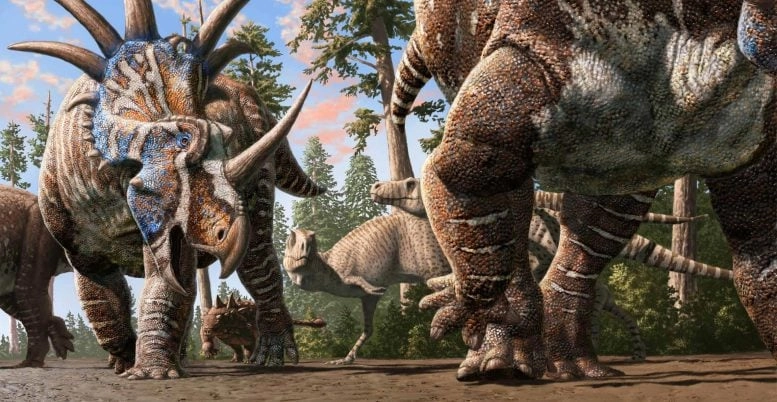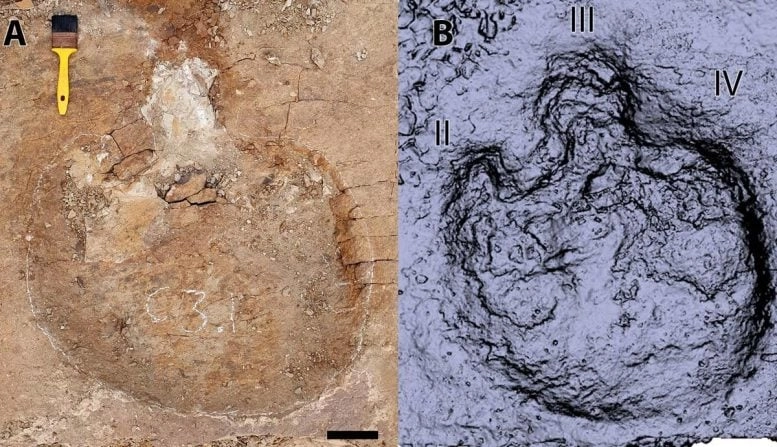 A collection of footprints from a group of ceratopsians and an Ankylosaurus could be the first evidence of dinosaur herds that were made up of multiple species. Credit: Julius Csotonyi
A collection of footprints from a group of ceratopsians and an Ankylosaurus could be the first evidence of dinosaur herds that were made up of multiple species. Credit: Julius Csotonyi
A groundbreaking discovery in Canada reveals that different dinosaur species may have traveled together in herds.
A newly published study in PLOS ONE reveals a remarkable discovery in Canada: fossilized footprints showing multiple dinosaur species moving together, offering rare evidence of interspecies social behavior dating back 76 million years.
This find comes from Dinosaur Provincial Park in Alberta, a site renowned worldwide for its wealth of dinosaur fossils. Despite its fame, the park had yielded almost no dinosaur footprints until now, making this tracksite a groundbreaking addition to its paleontological record.
Uncovered during an international field course in July 2024, the site preserves the tracks of several dinosaur species walking side by side. These footprints suggest that different types of dinosaurs may have traveled together in herds, much like how wildebeest and zebras migrate in groups today across the African savanna.
The researchers were also surprised to find the tracks of two large tyrannosaurs walking side by side and perpendicular to the herd, raising the prospect that multispecies herding may have been a defense strategy against common apex predators. However, more evidence is needed to confirm this.
Details of the Tracksite and Its Inhabitants
The international team, led by Dr. Brian Pickles (University of Reading, UK), Dr. Phil Bell (University of New England, Australia), and Dr. Caleb Brown (Royal Tyrrell Museum of Palaeontology, Canada), excavated 29 square metres of the site, revealing 13 ceratopsian (horned dinosaur) tracks from at least five animals walking side by side, with a probable ankylosaurid (armoured dinosaur) walking in the midst of the others.
 Footprints belonging to the tank-link armoured dinosaur called Ankylosaurus were found among the ceratopsian tracks. Credit: Dr. Brian Pickles, University of Reading
Footprints belonging to the tank-link armoured dinosaur called Ankylosaurus were found among the ceratopsian tracks. Credit: Dr. Brian Pickles, University of Reading
One footprint of a small meat-eating dinosaur was also discovered. The tracksite extends further into the hillside.
Dr. Phil Bell, University of New England, said: Ive collected dinosaur bones in Dinosaur Provincial Park for nearly 20 years, but Id never given footprints much thought. This rim of rock had the look of mud that had been squelched out between your toes, and I was immediately intrigued.
The tyrannosaur tracks give the sense that they were really eyeing up the herd, which is a pretty chilling thought, but we dont know for certain whether they actually crossed paths.
Dr. Brian Pickles, University of Reading, said: It was incredibly exciting to be walking in the footsteps of dinosaurs 76 million years after they laid them down.
Using the new search images for these footprints, we have been able to discover several more track sites within the varied terrain of the Park, which I am sure will tell us even more about how these fascinating creatures interacted with each other and behaved in their natural environment.
Dr. Caleb Brown, Royal Tyrrell Museum of Palaeontology, added: This discovery shows just how much there is still to uncover in dinosaur paleontology. Dinosaur Park is one of the best-understood dinosaur assemblages globally, with more than a century of intense collection and study, but it is only now that we are getting a sense for its full potential for dinosaur trackways.
Reference: A ceratopsid-dominated tracksite from the Dinosaur Park Formation (Campanian) at Dinosaur Provincial Park, Alberta, Canada by Phil R. Bell, Brian J. Pickles, Sarah C. Ashby, Issy E. Walker, Sally Hurst, Michael Rampe, Paul Durkin and Caleb M. Brown, 23 July 2025, PLOS ONE.
DOI: 10.1371/journal.pone.0324913
Never miss a breakthrough: Join the SciTechDaily newsletter.



